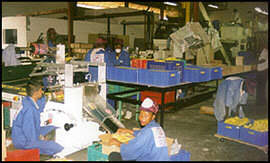 MANUFACTURING MANUFACTURING |

Traditionally in Liberia, manufacturing has been dominated by the iron ore and rubber semi-processing work. Notwithstanding, smaller industries produced consumer goods such as foodstuffs and beverages as well as clothing, cement, basic industrial chemicals, furniture and wood fixtures, soap, cigarettes and paint.
During this period in the early 1980s, this sector accounted for about 10% of the GDP, but declined to about 7.6% by the end of the decade of the eighties.
The decline was partly due to socio-political uncertainty and the recession caused by steep escalation in the costs of imported material upon which the manufacturing sector heavily depended.
The small size of the domestic market inhibited speedy growth, but the country served as a regional production base for several commodities, particularly with the Mano River Union economic grouping of Liberia, Guinea and Sierra Leone, until the events of unsavory political instability.
| Also affecting the local manufacturing industries were the low value-added in the production process and, in terms of its input/output relationship, a strong dependence on semi-finished imported inputs.
A highlight of the government investment plan is the utilization of local raw materials to obtain finished products.
But the manufacturing sector still shows signs of potential, constrained mainly by the lack of finance.
The virtual absence of credit flows to the private sector, in general, and especially to small-scale manufacturing entrepreneurs, may not be so much attributable to their inability to repay, but to their inability to provide required collateral, according to a Central Bank of Liberia report.
It may also be attributable to the banks' incapacity to manage the risks and costs of such transactions, the report states.
A sizable number of the country's industrial plants were looted, destroyed or abandoned, requiring time and fresh investment to revive the sector. New industries present a welcomed development. |

